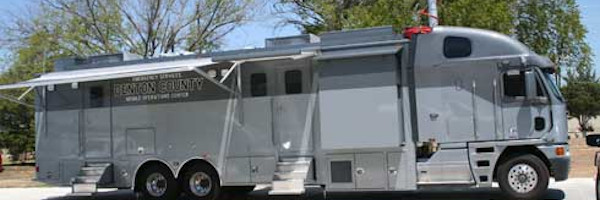Deployable Communications and Incident Command System for Emergency Response and Disaster Recovery: Difference between revisions
m (1 revision imported) |
No edit summary |
||
| (2 intermediate revisions by the same user not shown) | |||
| Line 1: | Line 1: | ||
{{ActionCluster | {{ActionCluster | ||
|image=DentonMobile.jpeg | |||
| | |team=University of North Texas, Civil Air Patrol, Penn State University, AirRobot, Dean Skidmore, LTE+IoT, Unmanned Experts | ||
| team | |leader=Kamesh Namuduri | ||
|imagecaption=Deployable Communications | |||
| leader | |municipalities=City of Denton TX | ||
|description=The integrated system will facilitate communications and information sharing during disaster recovery. It can be deployed in area where communications do not exist or failed due to disasters. The system will include (1) A Deployable Communication System, (2) Onboard Sensors (3) Next Generation Incident Command System and (4) Web Services | |||
|challenges=* Designing an communication node to facilitate communications among multiple stakeholders (citizens, first responders, and volunteers) | |||
| imagecaption | |||
| municipalities | |||
| description | |||
The integrated system will facilitate communications and information sharing during disaster recovery. It can be deployed in area where communications do not exist or failed due to disasters. The system will include (1) A Deployable Communication System, (2) Onboard Sensors (3) Next Generation Incident Command System and (4) Web Services | |||
| challenges | |||
* Designing an communication node to facilitate communications among multiple stakeholders (citizens, first responders, and volunteers) | |||
* Deploying the system during disaster recovery times | * Deploying the system during disaster recovery times | ||
* Extending the duration of operation of the system after deployment | * Extending the duration of operation of the system after deployment | ||
* Extending the ground coverage of the system | * Extending the ground coverage of the system | ||
|requirements=* Design of a deployable aerial base station | |||
| requirements | |||
* Design of a deployable aerial base station | |||
* Integrate onboard sensors on the platform | * Integrate onboard sensors on the platform | ||
* Integrate next generation incident command system | * Integrate next generation incident command system | ||
* Build necessary web services | * Build necessary web services | ||
* Field testing, performance evaluation, and assessment | * Field testing, performance evaluation, and assessment | ||
|kpi=Meet the requirements set by the National Public Safety Telecommunication Council (NPSTC) for deployable systems in terms of operations. | |||
| kpi | |measurement=* Duration of continuous operation of the deployable system | ||
Meet the requirements set by the National Public Safety Telecommunication Council (NPSTC) for deployable systems in terms of operations. | |||
| measurement | |||
* Duration of continuous operation of the deployable system | |||
* Quality of communication links established by the deployable system | * Quality of communication links established by the deployable system | ||
|standards=* Standards for deployable systems – as defined by NPSTC | |||
| standards | |||
* Standards for deployable systems – as defined by NPSTC | |||
* Standards for aerial communications – defined by IEEE and AEEC (Airlines Electronic Engineering Committee) | * Standards for aerial communications – defined by IEEE and AEEC (Airlines Electronic Engineering Committee) | ||
|impacts=Deployable systems facilitate communications among citizens and first responders during disaster recovery. Incident command system will facilitate sharing of information between the first responder network and decision makers. | |||
|demonstration=* Phase I Pilot/Demonstration: | |||
| impacts | |||
Deployable systems facilitate communications among citizens and first responders during disaster recovery. Incident command system will facilitate sharing of information between the first responder network and decision makers. | |||
| demonstration | |||
* Phase I Pilot/Demonstration: | |||
Deployable communication and incident command system | Deployable communication and incident command system | ||
* Phase II Deployment: | * Phase II Deployment: | ||
Deployable communication and incident command system with a set of web-based services | Deployable communication and incident command system with a set of web-based services | ||
|chapter=Communications Networks | |||
|supercluster=Public Safety | |||
| supercluster | |year=2017 | ||
| year | |title=Deployable Communications and Incident Command System for Emergency Response and Disaster Recovery | ||
|email=Kamesh.Namuduri@unt.edu | |||
}} | }} | ||
[[Category:Year_2016]] | [[Category:Year_2016]] | ||
[[Category:Year_2015]] | [[Category:Year_2015]] | ||
Latest revision as of 22:42, January 24, 2023
| Deployable Communications and Incident Command System for Emergency Response and Disaster Recovery | |
|---|---|

| |
 Deployable Communications | |
| Team Organizations | University of North Texas Civil Air Patrol Penn State University AirRobot Dean Skidmore LTE+IoT Unmanned Experts |
| Team Leaders | Kamesh Namuduri |
| Participating Municipalities | City of Denton TX |
| Status | {{{status}}}"{{{status}}}" is not in the list (Launched, Implemented, Development, Ready for Public Announcement, In Deliberations, Negotiations, Concept only Stage, Master Planning) of allowed values for the "Status" property. |
| Document | None |
Description
The integrated system will facilitate communications and information sharing during disaster recovery. It can be deployed in area where communications do not exist or failed due to disasters. The system will include (1) A Deployable Communication System, (2) Onboard Sensors (3) Next Generation Incident Command System and (4) Web Services
Challenges
- Designing an communication node to facilitate communications among multiple stakeholders (citizens, first responders, and volunteers)
- Deploying the system during disaster recovery times
- Extending the duration of operation of the system after deployment
- Extending the ground coverage of the system
Solutions
{{{solutions}}}
Major Requirements
- Design of a deployable aerial base station
- Integrate onboard sensors on the platform
- Integrate next generation incident command system
- Build necessary web services
- Field testing, performance evaluation, and assessment
Performance Targets
| Key Performance Indicators (KPIs) | Measurement Methods |
|---|---|
|
Meet the requirements set by the National Public Safety Telecommunication Council (NPSTC) for deployable systems in terms of operations. |
|
Standards, Replicability, Scalability, and Sustainability
- Standards for deployable systems – as defined by NPSTC
- Standards for aerial communications – defined by IEEE and AEEC (Airlines Electronic Engineering Committee)
Cybersecurity and Privacy
{{{cybersecurity}}}
Impacts
Deployable systems facilitate communications among citizens and first responders during disaster recovery. Incident command system will facilitate sharing of information between the first responder network and decision makers.
Demonstration/Deployment
- Phase I Pilot/Demonstration:
Deployable communication and incident command system
- Phase II Deployment:
Deployable communication and incident command system with a set of web-based services